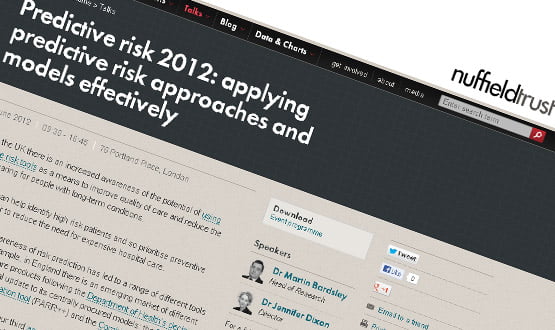Risky business
- 15 June 2012

Predictive risk modelling has come a long way in a decade. At a Nuffield Trust conference this week, the organisation’s head of research, Martin Bardsley, said interest in the idea started when the British Medical Journal published a series of papers about the work of US health management organisation Kaiser Permanente back in 2002.
“The studies talked about the quality of care that Kaiser delivered,” he said. “One dimension of that was the way that organisation was able to target people at high risk in order to focus services on them. That really led other people to look at risk.”
Data, crunching
At its most basic, predictive risk modelling is about collecting a lot of health data about a lot of people for a number of years and applying statistical tools to work out what factors were most important in their achieving a particular outcome.
Its best-known application in the NHS is ‘case finding’, or trying to find patients at high risk of needing an expensive NHS intervention – such as an unplanned hospital admission – in the hope of offering them enough alternative support to prevent it.
Anyone who has had anything to do with predictive risk modelling will have seen what Dr Bardsley called “the great pyramid of Kaiser.”
This is the famous triangle that rises from a broad base of people who are healthy and make virtually no use of health services to a tiny peak of people who are very unwell and make disproportionate use of healthcare resources.
The idea of case management is to “move people down the pyramid.” But predictive risk modelling can have other uses, such as financial planning or public health interventions.
The conference heard about a number of projects to identify patients with diabetes and chronic obstructive pulmonary disease, so they could be offered testing, monitoring, advice and treatment as necessary, and a GP keen to find ‘end of life’ patients not his practice’s end of life register.
Up to PARR
The best-known predictive risk tools in use in the NHS are the Patients at Risk of Re-hospitalisation or PARR tool that was developed by the King’s Fund, New York University and Health Dialog back in 2005, and its successors PARR++ and the Combined Predictive Model.
PARR, as its name implies, was developed as an “early warning system” for patients at risk of being readmitted to hospital within a year, while the CPM tries to identify patients – many of whom have multiple chronic conditions – at risk of needing hospital treatment in the future.
However, since the DH announced that it would no longer support PARR or CPM in August last year, a number of alternatives have been tried by the NHS, many of them offered by companies that also provide data handling services and display software.
Across the world, many other tools have also been developed for different uses. One speaker said that when he wanted to develop a diabetes project for East London, he found 145 tools to consider, based on different datasets and using statistical methods ranging from regression analysis to neural networks.
From model to plan
It is not just the models that have moved on. Across England, a number of healthcare communities have started to build innovative healthcare services that rely on risk modelling for recruitment.
Again, the best known are ‘virtual wards’ on which patients with complex conditions who might otherwise end up in hospital can be cared for by multi-disciplinary teams in their own homes.
But the conference heard from projects trying other interventions, from sending leaflets to people at risk of COPD to encourage them to contact their GP for testing or support, to setting up telecoaching and telehealth schemes.
Over the course of the day, it became clear that as these projects have developed they have encountered some common problems. One that was mentioned again and again was clinical resistance.
This appears to have stalled a big project in Wales to roll out a tool called PRISM, a web-based system that was to have allowed GPs to view their patient population, stratified by risk of emergency admission to hospital over the next 12 months.
But it also came up in relation to a project to give more than 200 GP practices in the South Central PCT Alliance area access to risk stratification and case finding tools, based on the Johns Hopkins University Adjusted Clinical Groups or ACG model.
Programme lead Alan Thompson said some GPs were already using the tool, for example to recruit patients to a community matron service in Buckinghamshire, where the initial pilot of ACG took place, but others were sceptical about whether it would find patients they did not know about.
Thompson said it did: “particularly people who do not use the GP practice but go to A&E for care, and people who have secondary care in London that is not captured locally.”
But he stressed that it was important to recognise that predictive risk tools are just tools, and that they need to be used alongside “other things” – including clinical judgement.
A pyramid in Devon
Another project, this time to recruit patients to virtual wards in Devon, went for a more direct approach. Todd Chenore, a senior information analyst, and Dr Paul Lovell, a GP principal and urgent care lead for NHS Devon, explained that practices were offered local enhanced service payments for recruiting patients to the wards.
However, these were dependent on a high proportion of these patients coming from the very top of the Kaiser Pyramid – “to make sure that we got the right intervention for the right people.”
Dr Lovell told eHealth Insider that although it is natural for doctors to think they know their patients “there is an element of those who shout loudest get heard the most” – in other words, that there will be some people who make few demands on their time who are, nevertheless, using other services.
An evaluation of the project showed that the locality that did best in terms of getting the highest proportion of very high risk patients onto the wards saw the biggest fall in unplanned hospital admissions.
Problems in New York
Reflecting on his experience of trying to set up a big case finding project for Medicaid patients in New York, Professor John Billings, associate professor at the Robert F Wagner Graduate School of Public Service in the city, said picking the right model was only the first step in a successful project.
He said it was just as important to get the right intervention and to implement the project effectively. The New York project decided that it wanted to create multi-disciplinary teams to support the 1% of patients most at risk of repeated hospital admission – many of whom were homeless and addicted to drink or drugs, as well as suffering from multiple health problems.
It worked out that to be effective it would need to have good links with housing and social care, good IT, and communications between team members and between team members and patients.
But in the end, financial silos made links with housing and social care difficult and the project suffered from poor IT and comms. Team members did not know if their patients were in hospital, and one pilot resorted to giving patients themselves mobile phones: “they lost a lot of mobile phones, but it did kinda solve the problem.”
In addition, it proved almost impossible to find many of the patients on the lists generated by the modelling, making the project almost impossible to evaluate. Despite this, the project has been rolled up into the ‘Obamacare’ Health Home project – and will now be rolled out to up to 700,000 people.
Opportunities and challenges
How to evaluate projects, when the model changes as soon as it is implemented, and there are so many other variables, was another theme of the conference. But there was still some optimism about the future of predictive risk modelling.
Speakers talked about the need to improve the sophistication of the models – for example by looking for and including more locally important factors, as Devon did for its virtual wards project (epilepsy and a short length of time with a GP practice turned out to be important local risk factors).
Others talked about the need “to get down below the 1%” and to start devising new and more sophisticated interventions for those lower down the pyramid.
However, there are also some challenges ahead. One of these is whether risk management tools and projects will survive in the new and reformed NHS.
The future of the South Central PCT Alliance, for example, is unclear, as it covers an area in which there will be at least two commissioning support services and many clinical commissioning groups. The localities covered by the NHS Devon virtual wards project have already been reshuffled.
Dr Lovell argued that CCGs might be a big opportunity, since the clinicians involved in them would have to “start looking across the population” to work effectively. Others wondered if GPs would be so keen, given the difficulties that so many projects have had of persuading them of the value of risk modelling to date.
The Nuffield Trust has published a guide to choosing a predictive risk model. More information about its work on predictive risk and its application can be found on its website.




